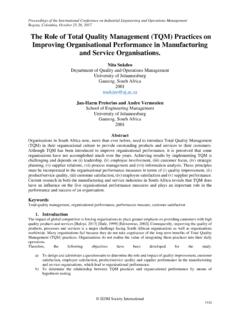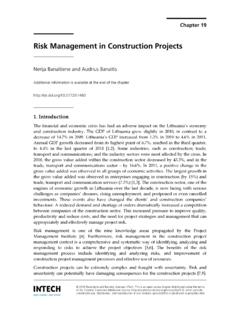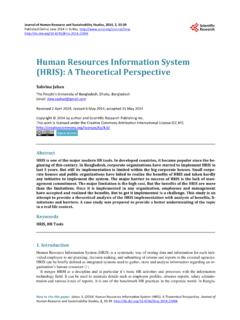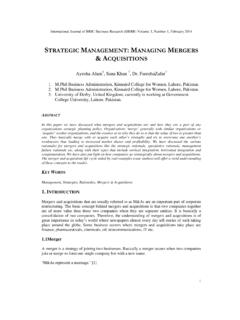Transcription of Six Sigma Approach to Health Carel Quality Management ...
1 The Use of Six Sigma in Healthcare Jayanta K. Bandyopadhyay And Karen Coppens Central Michigan University Mt. Pleasant, Michigan, International Journal of Quality & Productivity Management Bandyopadhyay and Volume 5, No. 1 December 15, 2005 Coppens Six Sigma Approach to Healthcare Quality and Productivity Management By Jayanta K. Bandyopadhyay and Karen Coppens Central Michigan University Abstract: For decades the Health care industry has been operating on its own way ignoring emerging factors such as competition, patient safety, skyrocketing Health care cost, liability, malpractice insurance cost and use of DRG for Medicare and insurance payment. However, as these factors became more prevalent and competition within the industry intensified, many hospitals have been becoming increasingly aware of the critical needs of controlling the operating costs and meet and even exceeds the expectations of patient care Quality .
2 This paper presents a model of Six Sigma Approach to Health care Quality Management for hospitals in the and abroad. Keywords: six Sigma , Quality and productivity Management in healthcare Introduction The Health care industry in the has been operating on its own traditional economic domain ignoring current emerging factors such as competition, patient safety, skyrocketing Health care cost, liability from malpractice lawsuits and more government control on Medicare payment.( Hansson, 2000). But in recent years, these factors have become more prevalent and competition within the industry has been intensified, and many hospitals has been becoming increasingly aware of the critical needs of controlling their operating costs and meet the expectations of patient care Quality (Chow-Chua ,2000).
3 In current competitive environment, many Health care organizations are taking steps to ensure that they are providing the "absolute best care at the lowest possible costs". However, many hospital administrators still have to learn how to lower operating costs without compromising on providing consistent good Quality patient care (Griffith, 2000). In 1993, Chaufournier et al. reported that 44% of 1,083 hospitals surveyed in the were embracing some kind of Quality Management Approach such as CQI (Continuous Quality improvement), Kaizen, and TQM ( total Quality Management ) to improve Health care Quality (Choufournier, 1993). Also, in 1994, Hertz, et. al suggested that Malcolm Baldrige National Quality Award (MBNQA) concepts could help stimulate Health care Quality improvement (Hertz 1994).
4 In 2001, Leggit, and Anderson reported that the Malcolm Baldrige National Quality Award (MBNQA) assessment criteria for performance excellence developed by National Institute of Standards and Technology has been successfully applied for organizational-wide performance improvement at Hartford Hospital at Hartford, Connecticut (Leggit, 2001). Under the current environment which contains many forces such as increased customer expectations, steeper competition, and government agency pressures the Health care delivery system has been undergoing formidable challenges since early 1990s (Chow-Chua 2002), V-1 International Journal of Quality & Productivity Management Bandyopadhyay and Volume 5, No. 1 December 15, 2005 Coppens and this paper presents a Model of a Six Sigma Approach to Quality Management to improve productivity and Quality in a Health care delivery system.
5 Six Sigma Approach to Quality improvement Six Sigma Approach to improve Quality has been used in many organizations since its inception. at Motorola Corporation in the 1980s to measure and improve product and service Quality . Six Sigma is focused on defects per million opportunities,. Six Sigma is based on a Quality statistic that equates to defects per million opportunities. This is the target level of performance for a process. Six Sigma DMAIC Quality Improvement Model The Six Sigma Quality improvement model as applied by Robert Galvin at Motorola, Inc refers to the five step process problem solving Approach known as DMAIC:(Define, Measure, Analyze, Improve and Control ) as explained below Define: this step defines who the customers are, what the customers want, the process capabilities, and provides objectives for project-based improvement efforts.
6 Measure: this step measures the Quality characteristics that reflects improvement in customer satisfaction and product performance and provides the metrics of data on which the improvement efforts will be Analyze: in this step, data collected in previous steps are analyzed using analytical tools such as Pareto analysis, process flow diagram, fish-bone diagram, statistical process control charts, for identifying necessary design and process modifications for achieving customer satisfaction and performance objectives. Improve: in this step resources are allocated so that design and process modifications needed for improvement can be implemented. Control: in this step the process is monitored using Quality Management tools such as Pareto charts, and statistical process control charts to ensure that the performance improvements are maintained.
7 The Six Sigma process is highly measurement and data driven. Data has to be gathered to determine the baseline performance of a process in order to validate that an improvement has been made. Decisions are made on statistics and facts, rather than instinct or past history. Six Sigma projects can be lead by Black Belts or Green Belts. ninjas (experts) who are trained for Quality problem solving. The Master Black Belt ninjas usually serve as advisors to the project leaders while local champions promote Six Sigma in their organizations. All of these roles require extensive training to become familiar with the tools of Six Sigma . Six Sigma projects that focus on improving/solving existing Quality problems follow the process of DMAIC (Define, Measure, Analyze, Improve, and Control) as described above.
8 While projects that involve developing a new product, process or procedure follow the DFSS (Design for Six Sigma ) process that focus on meeting customer needs and expectation, on time and on budget. V-2 International Journal of Quality & Productivity Management Bandyopadhyay and Volume 5, No. 1 December 15, 2005 Coppens Six Sigma s ability to reduce errors, improve customers satisfaction, and bring in financial gains has lead many companies such as General Electric, Texas Instruments, 3M, IBM, Citibank, Xerox, The Dow Chemical , and Boeing Aircraft to adopt the Six Sigma process. Six Sigma Approach to service industry Citibank is a service based company, used Six Sigma Approach to reduce cycle times within the company. Service based industries usually struggle with Six Sigma Approach because of its intense data focus.
9 There are three main challenges to overcome for implementing Six Sigma Approach in service industries (Lanser,2000). First, it is sometimes difficult for service industries to identify an indicator to measure the performance level of a service in their organization. Manufacturing plants can use measures such as no of defects per million parts produced. But it does not always translate into service industries. Customer variability also needs to be considered when using Six Sigma in service industries. A service might be acceptable to one customer but viewed as sub-par by another customer. A second issue to overcome in service industries is the difficulty in creating cultural changes for empowering Six Sigma leaders. The final challenge service organizations face in Six Sigma implementation is that it fails to capture the benefits of Six Sigma application immediately.
10 Cost savings from Six Sigma projects may take time to realize, and frequently, managers give up too soon before cost savings are realized. Six Sigma Approach to healthcare industry The challenge for Health care industry to benefit from the use of Six Sigma is paramount. Patient care significantly involves human element as compared to machine elements, in which the variability is subtle and very difficult to quantify. Therefore, challenge in adopting Six Sigma Approach to healthcare is to find a way to leverage the data from Six Sigma to drive human behavior. success will come only when the Six Sigma technical strategy is combined with a cultural strategy for change acceleration and a sound operational mechanism (Lasarus, Ian, and Neely, 2003) There are usually four metrics (indicators) that can be used by singly or in combination to define level of performance of a healthcare organization.





